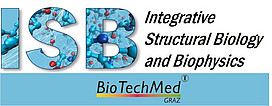End of this page section.
Go to overview of page sections.
Begin of page section: Additional information:
End of this page section.
Go to overview of page sections.
Research Projects
Begin of page section: Contents:
“Biomechanical and Microstructural Changes of the Aneurysmatic Aorta: Insights from Novel Imaging and Modeling Approaches”
This project aims to assess 3D micro-structural information on the collagen fiber organization of aneurysmatic human aortas. The method of choice is second-harmonic generation imaging; a straightforward approach was established by the consortium on non-atherosclerotic human abdominal aortic tissue samples (Schriefl et al. 2012; https://www.ncbi.nlm.nih.gov/pubmed/?term=23269845). Preliminary results on an abdominal aortic aneurysm sample suggest that its collagen structure is significantly altered compared to healthy arteries: the collagen fibril structure is partially lost in diseased arteries, and the dispersion along the thickness of the aortic wall becomes much more pronounced. A thorough structural analysis of healthy and diseased arteries serves the basis for biomechanical modeling and simulation.
Contact person: Professor Dr. Gerhard A. Holzapfel, Institute of Biomechanics, TU Graz
E-mail: holzapfel(at)tugraz.at
“Hardware Accelerated Intelligent Medical Imaging”
This project aims to perform world-class research in intelligent real-time medical imaging, image analysis algorithms and medical visualization. The implementation of novel high-performance computing methods for biomedical image analysis will be performed and the installation of an appropriate hardware environment at the designated research institute will be conducted.
Contact person: Professor Dr. Dieter Schmalstieg, Institute for Computer Graphics and Vision, TU Graz
E-mail: schmalstieg(at)icg.tu-graz.ac.at
“Integrative Omics to Elucidating Lipolysis in Cancer”
Cancer is a leading cause of death and involves altered lipid metabolism. The rate-limiting enzyme in triacylglyceride degradation, the adipose triglyceride lipase (ATGL), might not participate only in lipid mobilization and degradation, but also in signaling pathways by generating lipid signaling molecules. Therefore, we aim at the large-scale elucidation of the functional role of ATGL in cancer progression using different omics strategies combined with computational approaches. Novel bioinformatics methods are developed for analyzing the data of molecular proteomics and metabolomics networks related to lipolysis in cancer.
Contact person: Univ.-Prof. Dr. Christoph W. Sensen, Institute of Molecular Biotechnology, TU Graz
E-mail: csensen@tugraz.at
“Optimal Control Techniques for Electrocardiology”
The project aims at exploiting mathematical optimization strategies to safely stop electrical cardiac turbulences, which antecede sudden cardiac death, with shocks of significantly reduced energy. Such an optimization strategy sets out to apply successful shocks in such a way that they are below pain threshold. In addition novel sparsity constraint optimization techniques will be used to address the problem of optimal actuator placements strategies.
Contact person: Professor Dr. Karl Kunisch, Institute of Mathematics and Scientific Computing, University of Graz
E-Mail: karl.kunisch(at)uni-graz.at
End of this page section.
Go to overview of page sections.
Begin of page section:
BioTechMed-Graz Coordination Office
Mozartgasse 12/II
8010 Graz
Mag. Julia Rohrer
Margit List-Schleich, MA
MMag. Christina Prix
End of this page section.
Go to overview of page sections.


